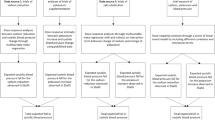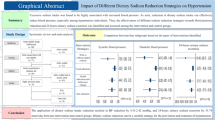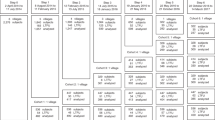Abstract
Hypertension remains the most common cardiovascular risk factor in developing countries, yet the majority of patients have no access to pharmacological therapy. Population-wide preventive strategies, such as salt restriction, are an attractive alternative, but experience in resource-poor settings is limited. To address this question, we conducted a randomized crossover study of salt restriction in adults living in Nigeria and Jamaica in order to estimate the mean blood pressure (BP) response. After a 4-week run-in period to determine willingness to adhere to a low-salt diet, 56 Jamaicans and 58 Nigerians completed an 8-week crossover study of low-salt and high-salt intake. Baseline BPs were in the normotensive range (systolic=125 mmHg in Jamaica, 114 mmHg in Nigeria). Baseline urinary sodium excretion was 86.8 and 125.6 mEq/day in Nigeria and Jamaica, respectively. The mean difference between urinary sodium excretion at baseline and at the end of the 3-week low-sodium phase was 33.6 mEq/day in Nigeria and 57.5 mEq/day in Jamaica. During the high-sodium phase, mean change in urinary sodium excretion from baseline to week 3 was 35.0 and 5.5 mEq/day in Nigeria and Jamaica, respectively. The mean change in systolic BP (‘high’ vs ‘low’ sodium phase) was approximately 5 mmHg in both groups. This study suggests that the efficacy of sodium reduction in developing countries equals those noted in more affluent cultures. If promoted on a wide scale, sodium reduction could be used to treat persons with established hypertension, and more importantly, to prevent age-related increases in BP in poor communities.
This is a preview of subscription content, access via your institution
Access options
Subscribe to this journal
Receive 12 digital issues and online access to articles
$119.00 per year
only $9.92 per issue
Buy this article
- Purchase on Springer Link
- Instant access to full article PDF
Prices may be subject to local taxes which are calculated during checkout




Similar content being viewed by others
References
Institute of Medicine. Control of cardiovascular diseases in developing countries: Research, development, and institutional strengthening. National Academy Press. http://www.nap.edu/books/0309061377/html/index.html 1998.
World Health Organization. The World Health Report, 2002. Geneva, Switzerland, http://www.who.int/whr/2002.
Cappuccio FP et al. Double-blind randomised trial of modest salt restriction in older people. Lancet 1997; 350: 850–854.
Svetkey LP et al. The DASH diet, sodium intake and blood pressure trial (DASH-sodium): rationale and design. DASH-Sodium Collaborative Research Group. J Am Diet Assoc 1999; 99: S96–S104.
Vollmer WM et al. Effects of diet and sodium intake on blood pressure: subgroup analysis of the DASH-sodium trial. Ann Intern Med 2001; 135: 1019–1028.
Law MR, Frost CD, Wald NJ . By how much does dietary salt reduction lower blood pressure? III—Analysis of data from trials of salt reduction. BMJ 1991; 302: 819–824.
Kaufman JS et al. Obesity and hypertension prevalence in populations of African origin. The Investigators of the International Collaborative Study on Hypertension in Blacks. Epidemiology 1996; 7: 398–405.
Adeyemo A et al. The feasibility of implementing a dietary sodium reduction intervention among free-living normotensive individuals in southwest Nigeria. Ethn Dis 2002; 12: 207–212.
Ataman SL et al. Standardization of blood pressure measurement in an international comparative study. J Clin Epidemiol 1996; 49: 869–877.
Brown H, Prescott R . Applied Mixed Models in Medicine. John Wiley and Sons, Ltd.: Chichester, 2001.
Cooper R et al. The prevalence of hypertension in seven populations of west African origin. Am J Public Health 1997; 87: 160–168.
Hurwitz S et al. Controlled analysis of blood pressure sensitivity to sodium intake: interactions with hypertension type. J Hypertens 2003; 21: 951–959.
Grim CE et al. Racial differences in blood pressure in Evans County, Georgia: relationship to sodium and potassium intake and plasma renin activity. J Chronic Dis 1980; 33: 87–94.
Dai WS, Kuller LH, Miller G . Arterial blood pressure and urinary electrolytes. J Chronic Dis 1984; 37: 75–84.
Watson RL et al. Urinary electrolytes, body weight, and blood pressure. Pooled cross-sectional results among four groups of adolescent females. Hypertension 1980; 2: 93–98.
Tobian L . The Volhard lecture. Potassium and sodium in hypertension. J Hypertens Suppl 1988; 6: S12–S24.
Tobian L . Dietary sodium chloride and potassium have effects on the pathophysiology of hypertension in humans and animals. Am J Clin Nutr 1997; 65: 606S–611S.
Gallen IW et al. On the mechanism of the effects of potassium restriction on blood pressure and renal sodium retention. Am J Kidney Dis 1998; 31: 19–27.
Author information
Authors and Affiliations
Corresponding author
Rights and permissions
About this article
Cite this article
Forrester, T., Adeyemo, A., Soarres-Wynter, S. et al. A randomized trial on sodium reduction in two developing countries. J Hum Hypertens 19, 55–60 (2005). https://doi.org/10.1038/sj.jhh.1001782
Received:
Revised:
Accepted:
Published:
Issue Date:
DOI: https://doi.org/10.1038/sj.jhh.1001782
Keywords
This article is cited by
-
Nonpharmacological interventions for the prevention of hypertension in low- and middle-income countries: a systematic review and meta-analysis
Journal of Human Hypertension (2019)
-
Salt intakes in sub-Saharan Africa: a systematic review and meta-regression
Population Health Metrics (2016)
-
Patterns of sodium and potassium excretion and blood pressure in the African Diaspora
Journal of Human Hypertension (2012)
-
Effects of Low-Sodium Diet vs. High-Sodium Diet on Blood Pressure, Renin, Aldosterone, Catecholamines, Cholesterol, and Triglyceride (Cochrane Review)
American Journal of Hypertension (2012)
-
Cardiovascular Disease Risk Factors in Blacks Living in the Caribbean
Current Cardiovascular Risk Reports (2010)



